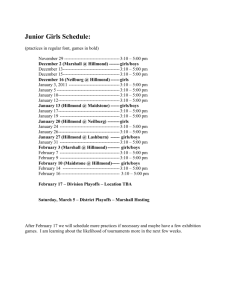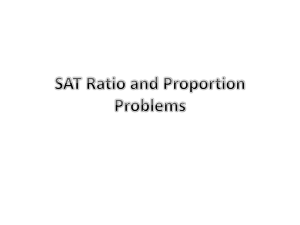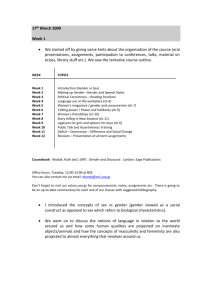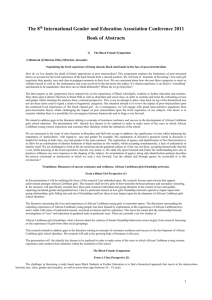How was the study designed?
advertisement
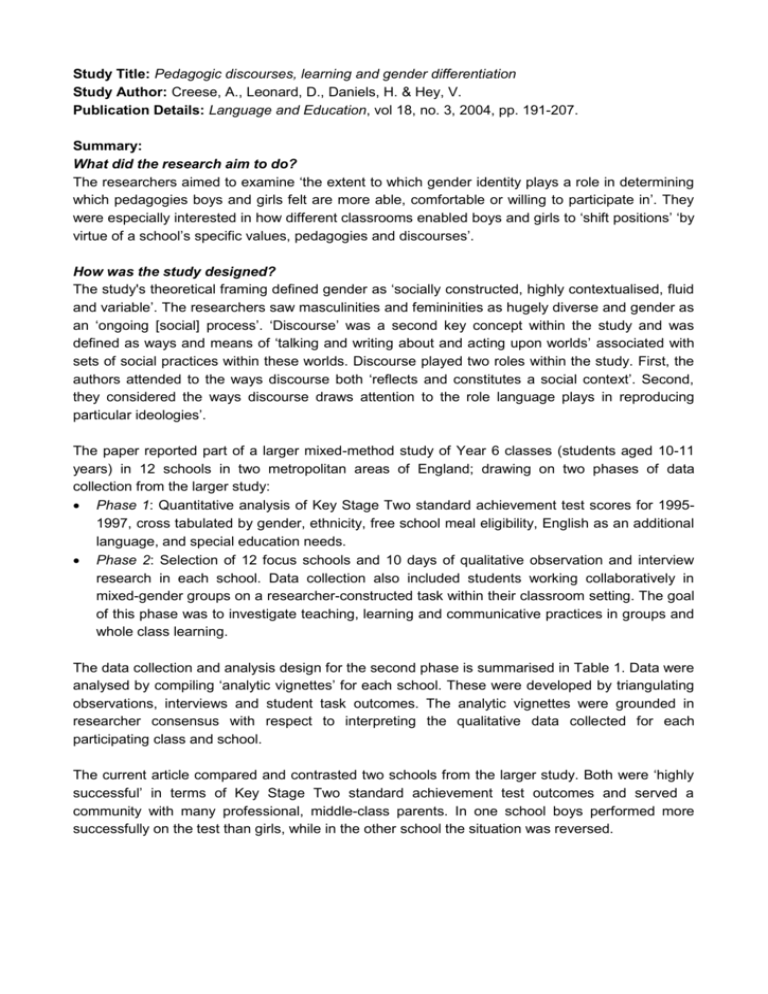
Study Title: Pedagogic discourses, learning and gender differentiation Study Author: Creese, A., Leonard, D., Daniels, H. & Hey, V. Publication Details: Language and Education, vol 18, no. 3, 2004, pp. 191-207. Summary: What did the research aim to do? The researchers aimed to examine ‘the extent to which gender identity plays a role in determining which pedagogies boys and girls felt are more able, comfortable or willing to participate in’. They were especially interested in how different classrooms enabled boys and girls to ‘shift positions’ ‘by virtue of a school’s specific values, pedagogies and discourses’. How was the study designed? The study's theoretical framing defined gender as ‘socially constructed, highly contextualised, fluid and variable’. The researchers saw masculinities and femininities as hugely diverse and gender as an ‘ongoing [social] process’. ‘Discourse’ was a second key concept within the study and was defined as ways and means of ‘talking and writing about and acting upon worlds’ associated with sets of social practices within these worlds. Discourse played two roles within the study. First, the authors attended to the ways discourse both ‘reflects and constitutes a social context’. Second, they considered the ways discourse draws attention to the role language plays in reproducing particular ideologies’. The paper reported part of a larger mixed-method study of Year 6 classes (students aged 10-11 years) in 12 schools in two metropolitan areas of England; drawing on two phases of data collection from the larger study: Phase 1: Quantitative analysis of Key Stage Two standard achievement test scores for 19951997, cross tabulated by gender, ethnicity, free school meal eligibility, English as an additional language, and special education needs. Phase 2: Selection of 12 focus schools and 10 days of qualitative observation and interview research in each school. Data collection also included students working collaboratively in mixed-gender groups on a researcher-constructed task within their classroom setting. The goal of this phase was to investigate teaching, learning and communicative practices in groups and whole class learning. The data collection and analysis design for the second phase is summarised in Table 1. Data were analysed by compiling ‘analytic vignettes’ for each school. These were developed by triangulating observations, interviews and student task outcomes. The analytic vignettes were grounded in researcher consensus with respect to interpreting the qualitative data collected for each participating class and school. The current article compared and contrasted two schools from the larger study. Both were ‘highly successful’ in terms of Key Stage Two standard achievement test outcomes and served a community with many professional, middle-class parents. In one school boys performed more successfully on the test than girls, while in the other school the situation was reversed. Table 1 Research methods across 10 participating schools Research method Research participants Research tool used Analysis Observations Two full weeks in nominated Key Stage 2 (KS2) classroom Participant observations and fieldnotes Analytic vignettes shared across research team Interviews Two interviews with headteacher who also nominated KS2 teacher Semi-structured and ethnographic interviews (audiorecorded) Thematic discourse analysis Two interviews with KS2 teacher Semi-structured and ethnographic interviews (audiorecorded) Thematic discourse analysis Friendship interviews (nominated by teacher): 1 boys’ group, 1 girls’ group Semi-structured (video recorded) Discourse analysis and microethnographic analysis One ‘average ability’ literacy hour learning group (nominated by teacher) Structured Discourse analysis and microethnographic analysis Research task group What were the findings? Findings suggest that ‘gender is not a determinate of who does well in each classroom’. Overall findings for each school can be summarised as follows: Millbank Year 6 classroom Cityscape Year 6 classroom Male teacher Competitive atmosphere Individualised, with little collaborative work among students Emphasis on expertise, original thinking and ‘standing out from the crowd’ within the classroom, and within the school as a whole Friendship seating arrangements Teacher as the main scaffolder of dialogue A sense of ‘teaching as performance’ High-performing boys and girls encouraged directly by the teacher Average-achieving students left to ‘coast along’ Female teacher Broadly collaborative pedagogy A ‘helping/helper’ culture within the classroom Evidence of ‘consensus talk’, where no one student dominates a conversation, students and teacher negotiate decisions, and students are comfortable with multiple explanatory accounts about a person/event/thing etc. Strong teacher emphasis on developing listening skills, matching a school-wide emphasis on ‘listening, debate, and respect for difference’ Teacher ‘facilitative talk’ to construct students as ‘co-learners’ High proportion of collaborative group work (mixed ability, males and females) Little explicit exposure to ‘discourses of expertise’ for girls (boys learn alternative gender positionings, while the girls rely more on traditional feminine positions in the classroom) The researchers found that middle-class girls at Millbank moved easily into and within discourses of expertise and ‘difference’, while middle-class boys were unable to shift far outside normative masculine gendered positions to engage effectively in more collaborative activity within their classroom. Being ‘ordinary and nice’ in this classroom was not valued highly by the teacher, and the student ‘winners’ also contributed to subordinating this social position through their own ways of talking and acting. Students at Cityscape collaborated effectively with each other, demonstrated tolerance towards others, and were able to live with multiple narratives and accounts of their world (e.g., one boy who refused to do any schoolwork was ‘excused’ by his fellow students in terms of being ‘new’, being ‘naughty’, being ‘clever’, or being ‘sporty’). The dominant facilitative communicative competence expected and practised in this classroom may, however, hinder some students—especially girls— from expanding their gender identities beyond traditional roles. What conclusions were drawn from the research? Both classrooms analysed in this study enabled boys and girls to take up ‘a variety of gender identity positions’ and both teachers ‘gave students opportunities to shift normative gendered identifications’. However, these opportunities did not hold equally for all students in each classroom. What are the implications of the study? The authors argued that teachers can benefit from ‘reflecting on their (discursive and other) practices and how these impact on different groups of students’. The article suggests that focusing exclusively on the learning and identity ‘needs’ of one gender group often comes at the expense of the learning and identities of other gender groups. It seems that teachers and their students will be served well by a classroom culture that promotes collaborative work and interactions, respect for difference, and a teacher who expects and encourages expertise and originality in all students’ work. Generalisability and significance for Queensland While two schools provide insufficient data for generalisation purposes, the fact that the study reported here was drawn from a larger and more extensive investigation lends additional weight to findings. England's Key Stage Two standard achievement test may not translate directly into Australian criteria for academic success at a Year 6 level. Furthermore, the teaching approaches observed in the two classrooms may be grounded in different conceptions of teaching to those operating in Australia. Where can interested readers find out more? Daniels, H., Creese, A., Fielding, S., Hey, V., Leonard, D. & Smith, M. 2001, ‘The gendering of social practices in special needs education’, in Learning in Classrooms: A Cultural-Historical Approach, ed. M. Hegegarrd, Aarhus University Press, Aarhus. Daniels, H., Creese, A., Hey, V., Leonard, D. & Smith, M. 2001, ‘Gender and learning: Equity, equality and pedagogy’, Support for Learning, vol. 16, no. 3, pp.112-16. Keywords: gender, pedagogy, reflective practice





